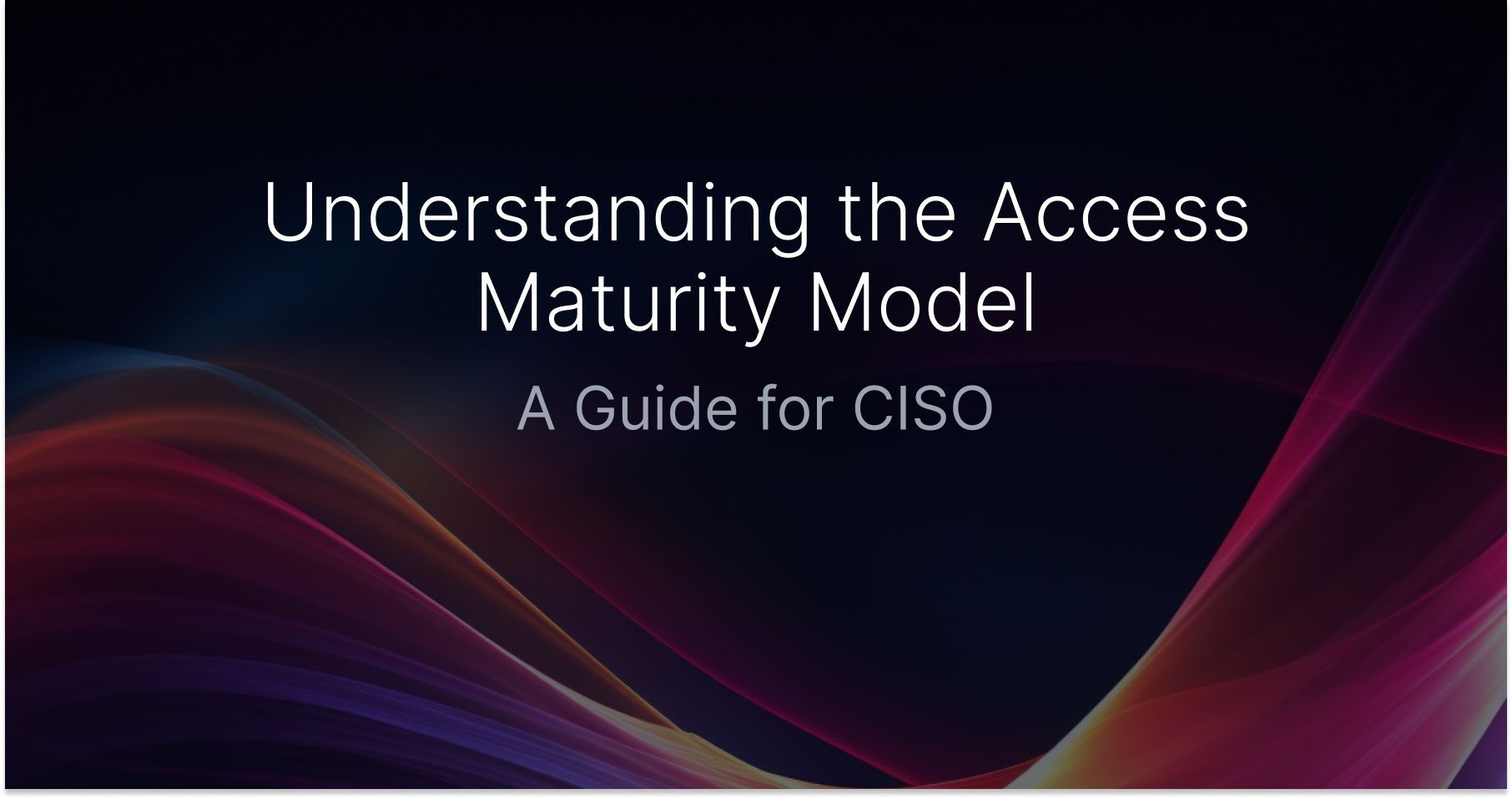Understanding the Access Maturity Model: A Guide for CISO

In today's evolving enterprise security landscape, how your organization manages access control can make or break your security posture. As companies grow, they typically progress through an Access Maturity Model – from a loose, high-trust environment to a rigorous Zero Trust framework. This journey spans four stages: Direct Access, Managed Access, Orchestrated Access, and Monitored Access. Each has distinct implications for security, productivity, and scalability. Understanding these stages will help IT managers align IT security maturity with business growth, ensuring that enterprise security models keep pace with organizational needs.
Stage 1: Direct Access – High Trust, High Velocity (Minimal Security)
At the first maturity stage, organizations operate in a high-trust environment. Access to systems and data is largely open and direct, with few barriers. The focus is on productivity and rapid innovation, so security controls are minimal. This “trust by default” approach often appears in small startups or new teams where everyone knows each other, and the priority is speed over security. Organizational velocity is fast because employees experience virtually no friction when accessing resources. However, this freedom comes at a cost to security. With no centralized access control, users often have broad or even unchecked permissions.
- Security Posture: Weak (highly vulnerable). There is little to no formal security policy. Critical systems may be left vulnerable due to ad-hoc or inconsistent controls
. For example, employees might have varying levels of access (even to sensitive data) without proper authorization, creating a chaotic and insecure environment
-
Organizational Needs: Speed and trust. In this stage, the business prioritizes agility and trusts team members implicitly. Security is “someone else’s problem” for later. There is minimal overhead for access management, which works when the team is small and stakes are low.
-
Scalability: Poor. The direct access model does not scale well. As more people join or data sensitivity increases, the lack of structured controls leads to confusion and risk. Without defined roles or least privilege principles, an organization at this stage will struggle to maintain security as it grows.
Implications: While Direct Access maximizes productivity in the short term, it leaves the organization one incident away from trouble. A single compromised account or insider mistake can expose everything. IT managers should recognize that this stage is only acceptable temporarily; advancing in maturity is critical to avoid glaring vulnerabilities.
Stage 2: Managed Access – Introducing Basic Controls (Compliance-Focused)
In the Managed Access stage, the organization acknowledges it has “something to secure.” This often happens as the company grows or starts handling more sensitive data. Basic access controls and policies emerge, but primarily to meet compliance demands or pass audits – security is present, yet not the primary focus. Think of this as the company “putting locks on the doors” not because of a specific threat, but because regulations or clients expect it. Trust is still relatively high internally, but now there are formal rules about who can access what.
-
Security Posture: Improved but reactive. The team establishes an IAM policy or rudimentary access management processes. However, these controls are often applied after issues arise or simply to check a box. In other words, security measures are defined but not deeply ingrained. For example, there may be a written access policy and some permission reviews, but the approach tends to address incidents after they occur rather than preventing them. The focus on compliance means being audit-ready, which doesn’t always equate to being truly secure
-
Organizational Needs: Compliance and basic protection. At this stage, external requirements (like SOC 2, HIPAA, or client security questionnaires) drive the adoption of access controls. The business needs evidence of control – e.g., maintaining user access lists, implementing simple role-based access control, and requiring approvals for certain systems. These measures improve trust with partners and regulators. However, because security isn’t yet a cultural priority, investments in it are minimal (just enough to satisfy requirements).
-
Scalability: Moderate. Managed Access is somewhat more scalable than Stage 1 because there is now structure. Yet, since many processes are manual or bolted-on, they can become bottlenecks as the organization grows. The IT team might struggle with growing workloads (e.g., handling numerous access requests manually). The controls can also introduce slight friction – for instance, employees might wait for access approvals – but in a small to mid-size environment this is usually still manageable.
Implications: Managed Access marks the beginning of a security-conscious culture. IT managers at this stage should ensure that compliance-driven controls also address real security risks, not just paperwork. While productivity may dip slightly due to new approval steps or password policies, these basic controls lay the groundwork for stronger security. The key is to avoid a false sense of security—being compliant is not the same as being secure. Organizations must continue evolving their access practices to stay ahead of threats.
Stage 3: Orchestrated Access – Structured Workflows and Proactive Security
Orchestrated Access is where security and access management become integral to operations. By this stage, the organization has grown significantly – with larger teams, more complex IT infrastructure, and a heightened awareness of security threats. Trust levels become more measured (“trust but verify”); there is neither blind trust nor needless suspicion. Instead, structured workflows ensure each access decision is deliberate and traceable. Often, companies in this stage deploy advanced Identity and Access Management tools or Identity Governance and Administration (IGA) solutions to automate and streamline user provisioning, access requests, and reviews.
-
Security Posture: Strong and proactive. The organization shifts from reacting to security incidents to anticipating them. Access controls are now robust and layered: for example, enforcing multi-factor authentication, adopting principle of least privilege across the board, and using adaptive access policies. The security team actively hunts for vulnerabilities and monitors access patterns. This proactive stance means potential risks are addressed before they escalate. The IAM policy at this stage is comprehensive, covering various scenarios and user roles.
-
Organizational Needs: Workflow integration and efficiency. With more employees and systems, manual access management is untenable. The business needs orchestrated workflows – such as automated user onboarding/offboarding, self-service access requests with manager approval, and periodic access recertifications. To achieve this, different systems are integrated. For instance, an enterprise might link its HR system, ticketing system (ITSM), and IAM platform to ensure when a user’s role changes, their access updates everywhere automatically. This level of integration (sometimes called access orchestration) greatly reduces errors and speeds up access changes.
-
Scalability: High. Orchestrated Access introduces automation and standardization, which improves scalability. Onboarding a new hire or expanding into a new product line is smoother because access is granted through defined roles and workflows. As the company continues to grow, this structured approach prevents the chaos of stage 1 and the resource strain of stage 2. There is some ongoing overhead (maintaining IAM systems and updating policies), but these are the investments that enable both security and productivity at scale.
Implications: In the orchestrated stage, access management becomes a business enabler rather than a hurdle. IT managers here are often key orchestrators, aligning security controls with business processes so that the right people have the right access at the right time. The result is a balanced environment of medium trust – employees are empowered to be productive, but checks and automation ensure that any access is justified and monitored. This stage significantly reduces the likelihood of breaches caused by oversight or manual error, because controls are systematic and security practices are embedded into daily operations.
Stage 4: Monitored Access (Walled Garden) – The Zero Trust Enterprise
The final stage of access maturity is a fully hardened and monitored environment, often likened to a “walled garden.” At this point, the organization treats security as mission-critical due to the high stakes (sensitive data, customer trust, regulatory obligations, and potential reputational or monetary damage from any breach). Nothing is taken for granted – Zero Trust security is the guiding model. In a Zero Trust or “verify-everything” architecture, being inside the network or on a company device doesn’t confer special trust. Every access request is authenticated, authorized, and encrypted no matter its origin. In practice, this means continuous validation of user identities and device health, strict segmentation of networks/data, and pervasive monitoring of activities.
-
Security Posture: Very strong (paranoid by design). The organization assumes breach by default and builds layers of defense accordingly. All access is micro-segmented – for example, even if a user is inside the corporate network, they may need to re-authenticate or meet specific criteria to access a particularly sensitive database. The Zero Trust principle of “always verify, never trust” is in full effect. Additionally, security teams implement continuous monitoring of user sessions and network traffic to spot anomalies or unauthorized behavior in real time. Any suspicious activity triggers alerts or automated responses (like isolating a device). This stage also tends to include advanced measures such as Just-In-Time access (granting elevated permissions only when needed and expiring them), strict device security compliance (ensuring endpoints are secure before they connect), and regular penetration testing.
-
Organizational Needs: Total protection and resilience. At Monitored Access maturity, the business typically operates in a high-risk or highly-regulated arena (finance, healthcare, large tech, government, etc.) where the cost of a breach is enormous. Every access point must be secured to avoid catastrophic financial losses or reputation damage from incidents. Moreover, the company likely has a dedicated security operations center (SOC) or equivalent, reflecting that security monitoring is a 24/7 requirement. Despite the heavy security emphasis, the organization also seeks to preserve usability – often by leveraging intelligent tooling that can enforce security without completely bogging down workflows. For example, single sign-on and well-tuned identity federations can ensure strong security with less user friction.
-
Scalability: Enterprise-grade. Monitored Access frameworks are designed to protect sprawling, complex IT ecosystems. They rely on scalable security architectures (cloud-based identity providers, global endpoint management, etc.) that can handle thousands of users and devices without breaking. In fact, achieving this level is often a response to scale: when a company has hundreds of applications and a globally distributed workforce, a manual or lax approach is impossible. The Zero Trust model, supported by automation, actually enables further growth because it creates clear guardrails. As new offices, products, or integrations come online, they are incorporated into the existing Zero Trust architecture, maintaining a consistent security posture.
Implications: Monitored Access (the “walled garden” of Zero Trust) represents the pinnacle of IT security maturity. Reaching this stage means an organization can confidently navigate sophisticated threats and strict regulations. For IT managers, it shifts the focus to fine-tuning and overseeing a complex security apparatus. The payoff is tremendous: the business is far less likely to suffer a damaging breach, and it gains the trust of customers, partners, and regulators through its demonstrable commitment to security. In short, security becomes a competitive advantage. A mature Zero Trust environment not only protects assets effectively but also signals that the company can be trusted with sensitive data, which is crucial for sustaining growth
Conclusion: Maturing Access Control in Line with Business Growth
The Access Maturity Model provides a roadmap for aligning your access control strategy with your organization's growth. Early on, speed and trust reign, but as the business expands, IT managers must elevate security maturity to protect what matters most. Progressing through Direct, Managed, Orchestrated, and Monitored Access stages yields clear benefits: stronger risk mitigation, improved compliance, and sustainable scalability. Each stage builds on the last – from basic policies to advanced Zero Trust practices – ensuring that security evolves from a simple safeguard into a strategic asset.
In practical terms, investing in access maturity means fewer breaches and disruptions (avoiding the costly fines, losses, and reputation hits that come with security incidents). It means a smoother user experience in the long run, as enterprise security models become more efficient at giving the right people the right access at the right time. Ultimately, a mature access control program underpins business growth by enabling innovation safely. IT managers who guide their organizations up the maturity curve will find that robust security and high productivity can go hand-in-hand – delivering confidence to stakeholders and agility to the business.
Investing in access maturity:
- Reduces breach risks and disruptions
- Improves audit and compliance posture
- Supports productivity and business agility
A mature access control program enables safe innovation. IT managers who guide their organizations up the maturity curve will unlock long-term success, with robust security and high productivity going hand in hand.
To learn more about access maturity model as well as modern identity security aspects contact us at info@adaptive.live
 SOC2 Type II
SOC2 Type II

